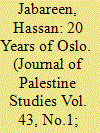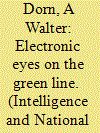|
|
|
Sort Order |
|
|
|
Items / Page
|
|
|
|
|
|
|
| Srl | Item |
| 1 |
ID:
128073


|
|
|
|
|
| Publication |
2014.
|
| Summary/Abstract |
The Oslo accords have been the subject of considerable debate ever since the
first agreement was signed in 1993. Most of the literature on the agreements
has dealt with their impact on the occupied territories (e.g. the growth of
settlements, the separation barrier, restrictions on movement), to the near
exclusion of the situation inside the Green Line. This essay, by contrast, focuses
on Oslo's consequences with regard to the status of the Palestinian citizens of
Israel, and the way that the conflict is conceptualized by Israeli Jewish society.
|
|
|
|
|
|
|
|
|
|
|
|
|
|
|
|
| 2 |
ID:
131107


|
|
|
|
|
| Publication |
2014.
|
| Summary/Abstract |
The 1974 Cypriot War divided the island of Cyprus into two parts with a narrow demilitarized zone (DMZ) between the opposing Greek Cypriot and Turkish forces. The volatility and violence in this zone, called the 'Green Line', necessitated a constant UN peacekeeping presence that was achieved mainly with manned observation posts (OPs). About 150 of these posts were established by 1975 to maintain stability and prevent flare-ups, including any lethal exchanges between the two sides. By the early 1990s, many of the countries contributing peacekeepers to the United Nations Peacekeeping Force in Cyprus (UNFICYP) had become tired of the stalemate and the lack of progress in negotiations (peacemaking), so they withdrew their troops from the force. This necessitated a reduction in the number of constantly manned OPs from 51 in 1992 to 21 in mid-1993. Further downsizing of UNFICYP by the UN Security Council in 2004 gave rise to a new approach to monitor the DMZ and produce actionable intelligence. Cameras were installed in hot-spots in the Nicosia DMZ and more responsive patrols were introduced as part of the new 'concentration with mobility' concept. This was the first time a UN peace operation used unattended cameras to monitor a demilitarized zone. This article examines the UN's difficulties and successes using the remote cameras, especially during important incidents. Other technologies that aided UNFICYP are also reviewed for lessons that might assist an under-equipped United Nations in its watchkeeping function.
|
|
|
|
|
|
|
|
|
|
|
|
|
|
|
|
| 3 |
ID:
158364


|
|
|
|
|
| Summary/Abstract |
The article analyses how the Europeans (meaning European states and the EC/EU) have progressively turned a discourse about the Israeli-Palestinian border into a foreign policy practice. While much of the literature highlights the existence of a ‘gap between discourse and practice’ when it comes to Europeans’ foreign policy stance towards the Arab-Israeli conflict, we argue that the gap is dynamic and has changed across time. In the absence of an internationally and locally recognised border between Israel and Palestine, the Europeans have aimed at constructing one on the 1949 armistice line, the so-called Green Line. They have done so in stages, by first formulating a discursive practice about the need for a border, then establishing economic practices in the late 1980s-early 1990s, and most recently practicing a legal frame of reference for relations with Israel and the Palestinian Authority (PA) based on the Green Line. The outcome is that, for what concerns European countries and EU legislation, the Green Line has been increasingly taken as the Israeli-Palestinian border. However, gaps never fully close and more contemporary events seem in fact to point to a re-opening of the gap, as the article explores.
|
|
|
|
|
|
|
|
|
|
|
|
|
|
|
|
| 4 |
ID:
172511


|
|
|
|
|
| Summary/Abstract |
Despite the EU accession of the Republic of Cyprus in 2004, the “Green Line” dividing Cyprus that was added as a border in 1974 remains an external EU-border between the Republic of Cyprus (RoC) and the Turkish Republic of Northern Cyprus (TRNC), a self-proclaimed state internationally recognized exclusively by Turkey. Pro- and con European attitudes on Cyprus are therefore not recent phenomena, but date back to the start of EU accession negotiations in 1998 and the Annan-Plan for reunification in 2004. These aspects, however, refer to the Turkish-Greek antagonism on the island and the ongoing national tensions that have resulted in violent conflicts since independence in 1960, the establishment of a demilitarized UN Buffer Zone in 1964 and the division of the island in 1974, also cutting through the island’s capital Nikosia/Lefkoşa. Drawing on fieldwork from 2004/2005 and 2014/2015 regarding the border’s shifting meanings and pointing to the border as a place where pro- and con-EU-articulations converge, emphasis is placed on the borderscape in Nikosia/Lefkoşa that impedes and increases the movement of people and goods. After all, the border is a dividing line that both shapes and exhibits identities. Moreover, it serves as an individual economic resource whilst border-crossings likewise offer benefits. Nevertheless, the border also stands as painful emotional remembrances for people on both sides. The pro- and con-EU attitudes that were dominant when the RoC joined the EU in 2004 have thus been blurred on both sides of the Green Line. The empirical research for this paper has been framed by the question of how this blurring is intertwined with the division of Cyprus and how people are affected by the Green Line as a socio-material and symbolic artefact on the micro-scale of personal feelings, identities and practices.
|
|
|
|
|
|
|
|
|
|
|
|
|
|
|
|
| 5 |
ID:
153368


|
|
|
|
|
|
|
|